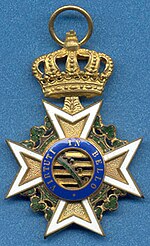Military Order of St. Henry
| Military Order of St. Henry (Militär-St. Heinrichs-Orden) | |
|---|---|
 
Wearer's copy (Spangenstück) of a Knight's Cross, obverse and reverse
|
|
| Awarded by |
|
| Type | Military Order of Merit |
| Eligibility | Saxon military officers and officers of allied states |
| Awarded for | Bravery and military merit |
| Status | Obsolete |
| Description | gold Maltese cross with a white-enameled border; the center medallion, ringed in blue enamel, features a portrait of St. Henry. Suspended from a royal crown. |
| Statistics | |
| Established | October 7, 1736 |
| First awarded | 1736 |
| Last awarded | 1918 |
| Precedence | |
| Next (higher) | Order of the Rue Crown |
| Next (lower) | Order of Albert |
|
Ribbon of the order |
|
The Military Order of St. Henry (Militär-St. Heinrichs-Orden) was a military order of the Kingdom of Saxony, a member state of the German Empire. The order was the oldest military order of the states of the German Empire. It was founded on October 7, 1736 by Augustus III, King of Poland and Elector of Saxony. The order underwent several more revisions over the course of the 19th and early 20th centuries. It became obsolete with the fall of the Saxon monarchy in the wake of Germany's defeat in World War I.
The order came in four classes: Grand Cross (Großkreuz), Commander's Cross 1st Class (Kommandeurkreuz I. Klasse), Commander's Cross 2nd Class (Kommandeurkreuz II. Klasse) or sometimes just Commander, and Knight's Cross (Ritterkreuz). Generally, the rank of the recipient determined which grade he would receive - the Grand Cross went to monarchs and the highest field commanders, the Commander 1st Class to senior generals, the Commander 2nd Class to officers major and above (with a few exceptions) and the Knight's Cross to all officers. Again with few exceptions, one was required to have received a lower grade before receiving the next higher grade. During World War I, there were 12 awards of the Grand Cross, 14 awards of the Commander 1st Class, 153 awards of the Commander 2nd Class, and 2,728 awards of the Knight's Cross As an example of the progression, Rupprecht, Crown Prince of Bavaria, a general and later field marshal, received the Knight's Cross in August 1914, the Commander 2nd Class in June 1915, the Commander 1st Class in January 1917, and the Grand Cross in May 1918.
The badge of the order was a gold Maltese cross with white-enameled edges. Around the center medallion was a blue-enameled gold ring bearing on the obverse the words "FRIDR•AUG•D•G•REX•SAX•INSTAURAVIT" and on the reverse the motto "VIRTUTI IN BELLO" ("Bravery in War"). On the obverse, the medallion was yellow-enameled with a painted portrait of St. Henry, the last Saxon Holy Roman Emperor. On the reverse, the medallion bore the Saxon coat of arms (alternating horizontal black and gold stripes with a diagonal rue crown). Between the arms of the cross were green-enameled rue crowns, a symbol of Saxony. The badge was suspended from a royal crown. The Grand Cross was larger than the Commander's Cross, and the Commander's Cross was larger than the Knight's Cross.
...
Wikipedia
